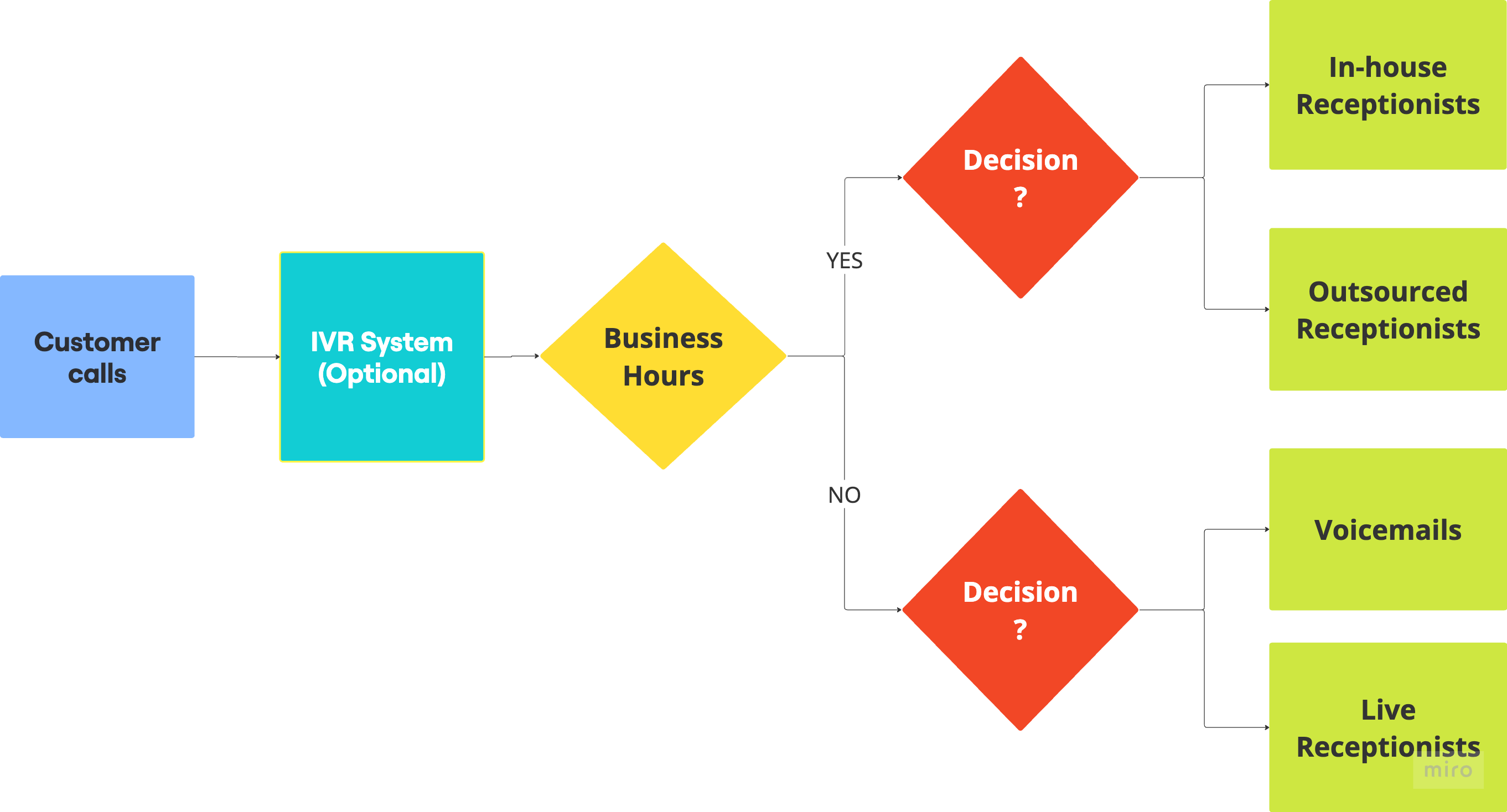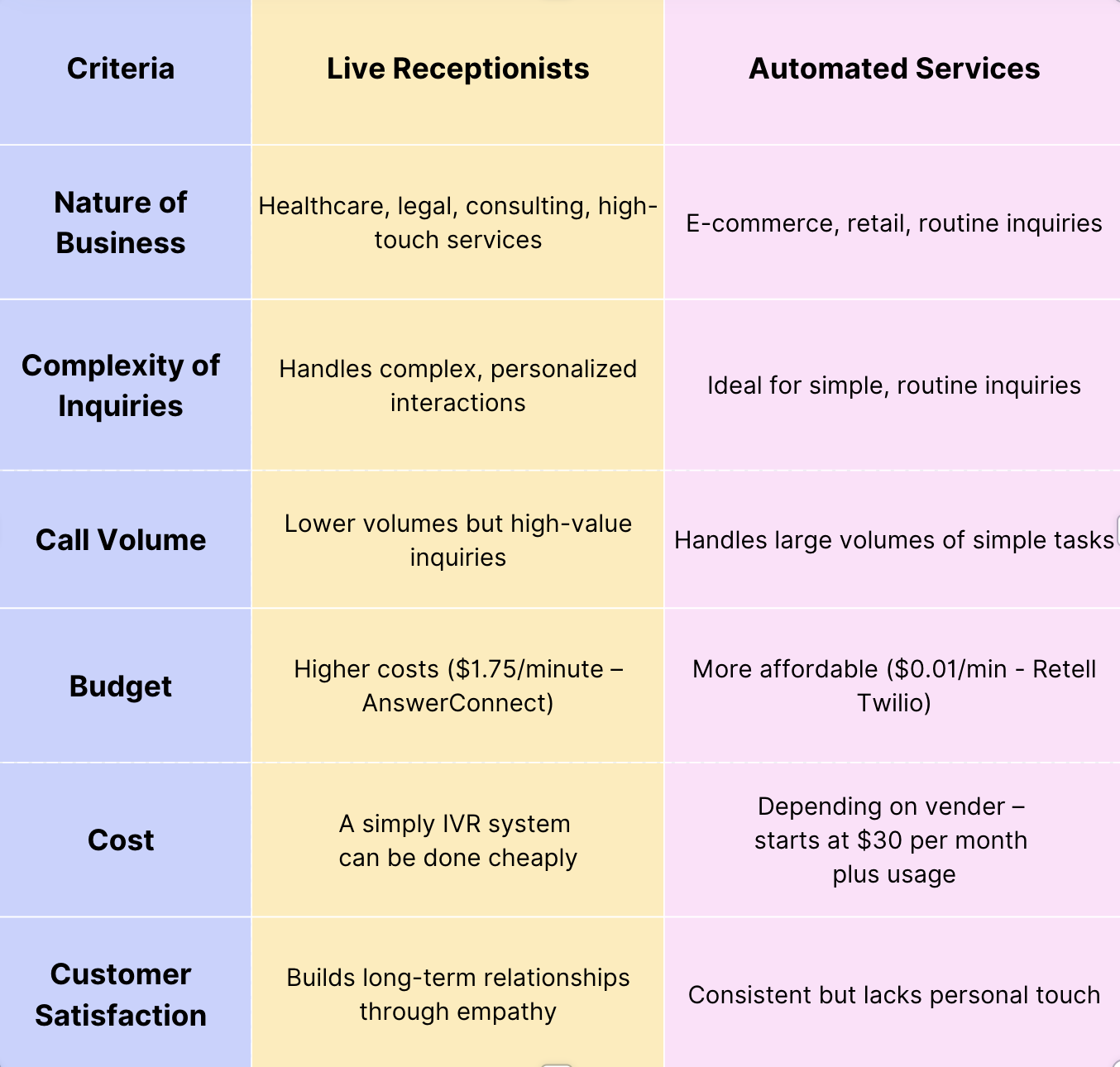This is a series of 5 articles exploring customer communication strategies for small businesses, focusing on answering services:

Why Small Businesses Need an Answering Service?: Discover the importance and benefits of answering services.
Outsourcing vs. In-house Live Receptionists: What are live receptionists? Should you outsource or hire in-house?
Automated Phone Answering Systems (Interactive Voice Response IVR vs. Voice AI Agents): What is an automated answering service? Should you use Interactive Voice Response or Voice AI agents?
(This Article) Decision: Should My Small Businesses Use Live Receptionists or Automated Answering Services?: You’ve learned all about answering services from our series. Now it’s time to decide which type of service is best for your business.
OpenAI vs. Human vs. Voice AI: A Cost Comparison: Wonder if you should switch to the latest voice AI technology? Let’s take a look at the real costs.
Introduction
When small businesses grow, managing inbound calls efficiently becomes vital. A key decision for business owners is whether to use live receptionists or automated answering services. Both play a crucial role in maintaining customer satisfaction and streamlining business operations. Live receptionists offer personalized interactions and can manage complex inquiries, while automated answering services are more cost-effective. Choosing the right service is essential for small businesses to balance efficiency, customer satisfaction, and cost-effectiveness. In this article, we’ll explore the differences, costs, and real-world demos of live receptionists and automated answering services.
24-Hour Answering Service: Why It Matters
In today’s competitive, customer-centric landscape, having a 24-hour answering service is essential for businesses aiming to stay ahead. Round-the-clock customer support ensures that no inquiry is missed, even outside of regular business hours. This is especially crucial for industries like healthcare, legal services, and e-commerce, where customers may need assistance at any time.
A 24-hour answering service allows businesses to capture leads, resolve inquiries promptly, and offer responsive customer service, no matter the time. For instance, a small law firm can benefit from this service by addressing client emergencies after hours, while an e-commerce business can provide real-time support across different time zones.
Whether through a live receptionist or automated system, offering 24/7 customer support can improve customer satisfaction, increase retention, and boost business growth.
The Difference Between Live and Automated Answering Services
When deciding between live receptionists and automated systems, small businesses must weigh the benefits of human interaction against the efficiency and cost savings of automation.
Live Receptionists: Personalized Customer Care
Live receptionists offer a personal touch that automated systems struggle to replicate. In scenarios requiring empathy, such as a legal client calling with an urgent matter or a healthcare patient seeking reassurance, live receptionists can adapt their tone and responses to suit the situation. They can assess the caller’s emotions, provide tailored support, and connect them with the right professional—fostering trust and building long-term relationships.
Automated Answering Systems: Efficiency and Cost Savings
Automated answering systems are ideal for handling routine inquiries. For example, an e-commerce business might use an automated system to manage order status or shipping queries, routing calls to pre-recorded messages for quick responses. With advancements in AI-driven answering services, automated systems are becoming more sophisticated, capable of managing more complex tasks such as scheduling appointments or answering product-specific questions.
However, these systems lack the emotional intelligence of live receptionists, which can result in customer frustration if their needs don’t align with the system’s pre-programmed responses. That said, automated systems offer cost savings, with prices as low as $30 per month, making them a viable option for businesses with limited budgets or high volumes of routine calls.
Here is a diagram that can help businesses decide what kind of answering services meets their needs the best:

Live Receptionist vs. Automated Systems: Cost Comparison
When evaluating the costs of live receptionists versus automated systems, small businesses must consider both short-term and long-term implications.
Live Receptionists: The Value of Human Interaction
The cost of hiring a live receptionist varies based on the service provider, call volume, and services required. On average, in-house live receptionist services range from $1000 to $2,500 per month. While this may seem like a significant investment, the personalized customer service and increased satisfaction they provide can justify the expense. Additionally, live receptionists prevent missed calls, ensuring businesses don’t lose potential opportunities or customers.
Automated Systems: A Lower-Cost Alternative
Automated systems, particularly AI-driven answering services, offer a more cost-effective solution. These systems typically cost between $30 and $200 per month, depending on the complexity of the service and the number of calls handled. While they are more affordable, businesses should consider the trade-offs in terms of customer experience, as automated answering systems often lack the personal engagement that live receptionists provide.
Vendor Recommendation – Retell AI:
Retell AI is a robust voice AI solution designed to streamline call operations with advanced AI technology, enhancing efficiency by automating customer interactions with intelligent voice agents.
Automated System Pricing:
- Pay-as-you-go Package – Price can vary based on the businesses’ call volume.
Recommended Use Cases:
- Healthcare: Automates patient follow-ups and scheduling while ensuring compliance with GDPR and SOC 2 Type 1.
- Sales: Scales sales efforts quickly with over half a million calls made.
- Finance: Manages over 30% of calls, compared to 5% with traditional IVR systems.
Demo – Call Handling
Hybrid Approach: A Mix of Live Receptionists and Automated Services
Many businesses find that a hybrid model offers the best of both worlds. By combining live receptionists with automated systems, companies can benefit from both personalization and cost-efficiency.
By combining both options, businesses can manage calls more efficiently while keeping costs lower than relying solely on live receptionists. Here are some hybrid approaches that businesses can consider to adapt to their existing production if they are choosing between the solutions of live receptionist and automated services.
Vendor Recommendation – SeaChat:
With SeaChat, businesses can set up an AI agent for answering calls. The AI handles routine tasks, but callers can be transferred to a live agent if needed. This hybrid approach ensures that no customer inquiry is missed, while still offering the personal touch of human interaction. This approach allows the user to delegate the task of routing and appointment scheduling to AI agents and keep the live receptionist on the phone lines for calls while saving costs on both tasks.
Hybrid Model Pricing:
Live Receptionist:
- In-house Receptionist (Cost varies depending on the sector)
- Outsourced Receptionist (Basic: pay-as-you-go package, $30 - $50/ Premium: $500 - 2000 per month )
SeaChat (AI): Premium Package starts at $30/month
Recommended Use Cases:
- Healthcare Services: A Singaporean social service organization collaborated with SeaChat to successfully reduce up to 10,000 phone calls made by volunteers per year, while simultaneously increasing the frequency of monthly phone call surveys for the elderly.
- E-Commerce & Retail: Integrates with the WhatsApp Business API, enhancing customer service and driving sales through efficient communication.
- Service Industries: Automates 24/7 call answering, streamlining appointment bookings and handling urgent customer inquiries.
Demo – Appointment Booking
The Bottom Line
While live receptionists have higher upfront costs, they often yield a greater return on investment (ROI) by improving customer satisfaction and reducing lost business. Automated answering systems, on the other hand, provide a more scalable and budget-friendly option for businesses focused on efficiency. Ultimately, business owners should weigh their specific needs and customer service goals when deciding between the two.
Assessing Business Needs: Live Receptionists or Automated Services?
To help small businesses decide which service is the best fit, we’ve created a guide based on key factors such as business type, call volume, and budget.

Small businesses with frequent, simple inquiries may find automated services to be more cost-effective. For businesses that depend on customer loyalty and personal connections, live receptionists are worth the investment.
Case Studies: Restaurants Using Live Receptionists Or Voice AI Agents
Lil Beaver Brewery in Illinois uses Slang.ai to pick up incoming phone calls. It answers questions on menus, driving directions and transfers to a live agent. When a customer calls, the welcoming AI voice comes with strong beats and music, matching the vibes of a brewery. According to Slang AI, restaurants can customize their digital voice and background soundscape. Restaurants will also have real-time analytics for callers and save 200 hours per month on average. Customer satisfactory rate is in the 80%+ range.
Slang AI’s basic plan starts at $199 per month, and goes up to $599 per month for the premium plan.
STK Steakhouse in Washington on the other hand uses a centralized live receptionist service. This is because the whole restaurant group owns several locations, and they have live agents answering phone calls for all restaurants. When a customer calls in, the human agent, who might be based in New York, answers questions about common inquiries.
Real-Life Experience with the Two Services
The following is the experience of a user who have experienced the two different services:
I once asked the restaurant whether it provides a bike rack to park my bike that doesn’t have a lock. The human agent did not know the answer, and then said “hold on a moment, let me talk to the restaurant”. That’s how I figured out the agent was not on site and probably remote.
Then the agent put me on hold for a few minutes and came back with an answer. Yes, they provide bike storage!
When I visited the restaurant in person (with my bike), the receptionists did say that they use a remote agent to handle all the incoming calls. Sometimes they still get internal calls from the agents for clarifications.
These are two cases of real restaurants outsourcing their phone call receptionists to an outside provider – let it be human or AI. Eventually, the choice is yours!
Conclusion
Live receptionists and automated answering services each have their strengths. Live receptionists offer empathy, adaptability, and problem-solving skills, making them ideal for businesses that rely on personal connections. Automated systems, on the other hand, are cost-effective, scalable, and available 24/7, perfect for handling high volumes of routine inquiries.
For small businesses, the choice depends on specific needs, call volumes, and budgets. For many, a hybrid approach that uses AI for routine tasks while live agents handle complex inquiries might be the most efficient and affordable option.
Recommendation of Case Studies
To make the best decision that suits your business needs, we recommend trying demos from the different service vendors first to get first-hand experience for comparison. Test their services to see what fits your business best. You can also join online communities, like Reddit or YouTube, to explore real user experiences before making a final choice.
About this Series
This is a series of 5 articles exploring customer communication strategies for small businesses, focusing on answering services:
Why Small Businesses Need an Answering Service?: Discover the importance and benefits of answering services.
Outsourcing vs. In-house Live Receptionists: What is live receptionists? Should you outsource or hire in-house?
Automated Phone Answering Systems (Interactive Voice Response IVR vs. Voice AI Agents): What is automated answering service? Should you use robotic IVR or Voice AI agents?
(This Article) Decision: Should My Small Businesses Use Live Receptionists or Automated Answering Services?: You’ve learned all about answering services from our series. Now it’s time to decide which type of service is best for your business.
OpenAI vs. Human vs. Voice AI: A Cost Comparison: The latest voice AI technology from OpenAI is a great voice AI agent. What is the real cost?


 Subscribe
Subscribe